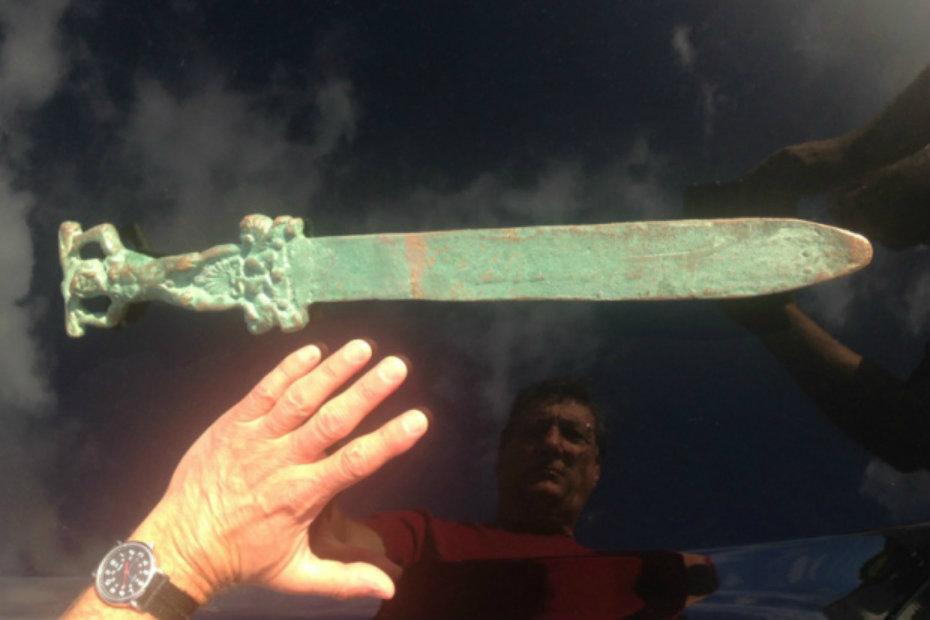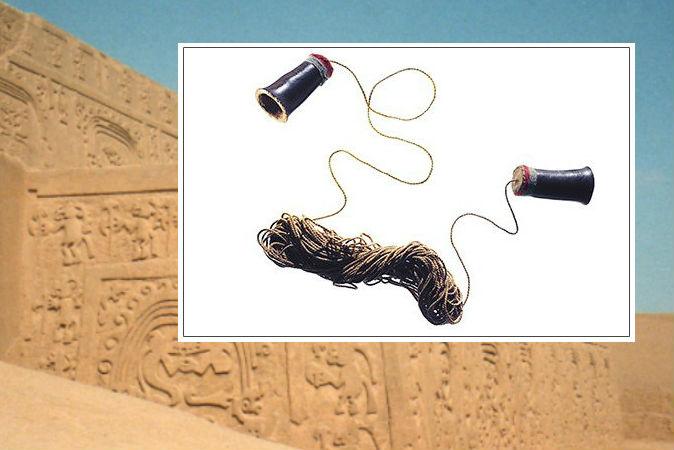Reconsidering History
Uncover the truth about historical events and figures | Reconsidering History series. Explore untold stories and fresh perspectives on the past.
Reconsidering History | LATEST STORIES
Ancient Travels to the Americas or a Modern Forgery? Who Made the Bat Creek Inscription?
A mysterious inscription on a mysterious artifact has been theorized by some to be Cherokee, Semitic, or Welsh, all intriguing possibilities.
|
The Truth About Father Crespi’s Controversial Missing Artifacts
Ancient Origins investigates artifacts in Ecuador that could provide evidence of unknown civilizations, connections between America and Sumeria, a Vatican conspiracy, and more.
|
Tucson Artifacts Suggest Romans Made It to New World in 8th Century: Expert
Medieval scholar Donald Yates, Ph.D., is shedding new light on controversial artifacts found near Tuscon, Ariz., in the 1920s.
|
Exclusive: New Evidence Ancient Romans May Have Made It to Oak Island, Canada
What appears to be an ancient Roman sword has been found off the East Coast of Canada, and it is just one of several indications that Romans were there around 200 A.D.
|
Roman Sword Discovered Near Oak Island Suggests New World Contact 1,000 Years Before Columbus
Investigators have found what is believed to be a Roman shipwreck of the coast of Canada, suggesting the ancient Romans made it to the New World.
|
1,200-Year-Old Telephone, Amazing Invention of the Ancient Chimu Civilization
This advanced device “comes from the consciousness of an indigenous society with no written language,” said anthropologist Ramiro Matos.
|
Underwater Discovery: 9,300-Year-Old Pillar Evidence of Advanced Society, Say Researchers
The idea of “technological primitivism” often attributed to hunter-gatherer coastal settlers must be reevaluated, say Emanuele Lodolo and Zvi Ben-Abraham.
|
Out of Place in Time: Petrified Wooden Tools Buried Deep in Limestone
They had dug through 11 layers of limestone, each separated by a bed of sand mixed with clay, and there they found wooden hammer handles and other wooden tools petrified into agate.
|
Drill Bit Found in Coal Suggests Advanced Civilization LONG Before Humans Thought to Walk Earth?
Oopart (out of place artifact) is a term applied to dozens of prehistoric objects found in various places around the world that seem to show a level of technological advancement incongruous with the times in which they were made.
|
New Discovery of Prehistoric Underground Tunnels at Bosnian Pyramids
The Bosnian Pyramids are said by some to be man-made, but some say they are natural formations. Sam Osmanagich, Ph.D., continues to excavate and says he has found much evidence of a prehistoric culture responsible for building the pyramids.
|
Is This a 1.7-Million-Year-Old Man-Made Bridge?
Is this bridge a natural formation, or was it man-made, corresponding to an ancient Indian legend?
|
Ancient Greek Legend Seems to Describe a Place in Peru: Early Contact?
Hesiod’s description of the ancient Greek dwelling place of gorgons seems to match the mysterious labyrinth ruins of Chavin de Huantar in the Peruvian Andes.
|
Inscriptions on Uruguay Coast Suggest West Africans Beat Columbus to Americas
Do inscriptions on the coast of Uruguay tell of an expedition that could dramatically change history books?
|
New Evidence Ancient Chinese Explorers Landed in America Excites Experts
Will the history books change? Evidence suggests the Chinese got to America before the Europeans.
|
Is This Really a 250-Million-Year-Old Microchip?
Was there computer technology 250 million years ago? Epoch Times investigated this much-discussed discovery.
|
Did Humans Walk the Earth With Dinosaurs? Triceratops Horn Dated to 33,500 Years
A triceratops brow horn discovered in Dawson County, Mont., has been controversially dated to around 33,500 years, challenging the view that dinosaurs died out around 65 million years ago.
|
Ancient Travels to the Americas or a Modern Forgery? Who Made the Bat Creek Inscription?
A mysterious inscription on a mysterious artifact has been theorized by some to be Cherokee, Semitic, or Welsh, all intriguing possibilities.
|
The Truth About Father Crespi’s Controversial Missing Artifacts
Ancient Origins investigates artifacts in Ecuador that could provide evidence of unknown civilizations, connections between America and Sumeria, a Vatican conspiracy, and more.
|
Tucson Artifacts Suggest Romans Made It to New World in 8th Century: Expert
Medieval scholar Donald Yates, Ph.D., is shedding new light on controversial artifacts found near Tuscon, Ariz., in the 1920s.
|
Exclusive: New Evidence Ancient Romans May Have Made It to Oak Island, Canada
What appears to be an ancient Roman sword has been found off the East Coast of Canada, and it is just one of several indications that Romans were there around 200 A.D.
|
Roman Sword Discovered Near Oak Island Suggests New World Contact 1,000 Years Before Columbus
Investigators have found what is believed to be a Roman shipwreck of the coast of Canada, suggesting the ancient Romans made it to the New World.
|
1,200-Year-Old Telephone, Amazing Invention of the Ancient Chimu Civilization
This advanced device “comes from the consciousness of an indigenous society with no written language,” said anthropologist Ramiro Matos.
|
Underwater Discovery: 9,300-Year-Old Pillar Evidence of Advanced Society, Say Researchers
The idea of “technological primitivism” often attributed to hunter-gatherer coastal settlers must be reevaluated, say Emanuele Lodolo and Zvi Ben-Abraham.
|
Out of Place in Time: Petrified Wooden Tools Buried Deep in Limestone
They had dug through 11 layers of limestone, each separated by a bed of sand mixed with clay, and there they found wooden hammer handles and other wooden tools petrified into agate.
|
Drill Bit Found in Coal Suggests Advanced Civilization LONG Before Humans Thought to Walk Earth?
Oopart (out of place artifact) is a term applied to dozens of prehistoric objects found in various places around the world that seem to show a level of technological advancement incongruous with the times in which they were made.
|
New Discovery of Prehistoric Underground Tunnels at Bosnian Pyramids
The Bosnian Pyramids are said by some to be man-made, but some say they are natural formations. Sam Osmanagich, Ph.D., continues to excavate and says he has found much evidence of a prehistoric culture responsible for building the pyramids.
|
Is This a 1.7-Million-Year-Old Man-Made Bridge?
Is this bridge a natural formation, or was it man-made, corresponding to an ancient Indian legend?
|
Ancient Greek Legend Seems to Describe a Place in Peru: Early Contact?
Hesiod’s description of the ancient Greek dwelling place of gorgons seems to match the mysterious labyrinth ruins of Chavin de Huantar in the Peruvian Andes.
|
Inscriptions on Uruguay Coast Suggest West Africans Beat Columbus to Americas
Do inscriptions on the coast of Uruguay tell of an expedition that could dramatically change history books?
|
New Evidence Ancient Chinese Explorers Landed in America Excites Experts
Will the history books change? Evidence suggests the Chinese got to America before the Europeans.
|
Is This Really a 250-Million-Year-Old Microchip?
Was there computer technology 250 million years ago? Epoch Times investigated this much-discussed discovery.
|
Did Humans Walk the Earth With Dinosaurs? Triceratops Horn Dated to 33,500 Years
A triceratops brow horn discovered in Dawson County, Mont., has been controversially dated to around 33,500 years, challenging the view that dinosaurs died out around 65 million years ago.
|





















